JavaScript Analyzer
The JavaScript Analyzer (JSA) is an analysis tool, which helps to find problems in JavaScript code. When you develop a Web application with a new project in the IDE, you can run JSA to detect potential problems in your JavaScript code.
JSA supports 2 analyzer types:
-
Static Analyzer (Coding Rule Checker)
Contains checkers for a set of predefined coding rules. It supports 27 rules, including coding rules and Web API usage rules.
The Coding Rule Checker is a static analysis tool that evaluates an application by examining the JavaScript code without its execution. This type of checkers examine all possible execution paths and variable values, and then provide its their analysis result.
-
Dynamic Analyzer (Stale Object Checker)
Contains a checker for stale objects that cause possible memory leaks.
The Stale Object Checker is a dynamic analysis tool that requires executing the application on a runtime environment for its analysis. This checker examines all the JavaScript objects created during its execution and points out relatively critical staled objects.
Using the JavaScript Analyzer
To analyze a Web application with the JSA in the Tizen IDE, choose the target project in the Project Explorer view, open the context menu, and select Check JavaScript Rules.
Figure: JSA in the menu

The JSA analyzes JavaScript codes in the selected Web application project after selecting JavaScript files and code segments to analyze. This can be done by parsing the start HTML file (such as index.html) specified in the config.xml file.
Figure: Checking in progress

If JavaScript Analyzer detects codes that can cause potential problems during its analysis step, the problems are listed up in the Problems view. If you want to locate a possibly problematic code line, double-click the alarm in the view.
Figure: Problems view

Setting JavaScript Rules
You can enable or disable the JavaScript rules in JavaScript Analyzer preferences.
To enable or disable the rules:
- In the Tizen IDE, go to Window > Preferences > JavaScript Analyzer.
- Select or clear a rule checkbox to enable or disable the rule.
Figure: Preferences
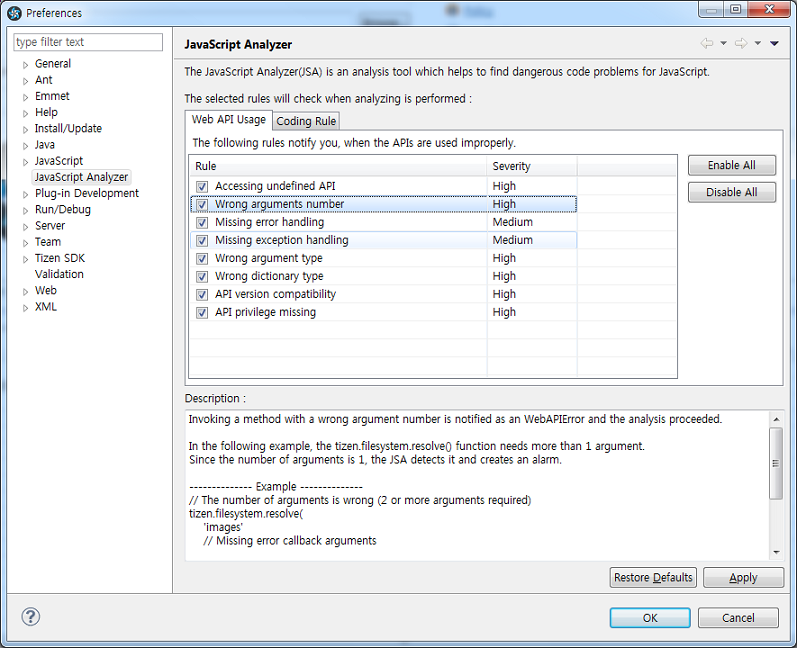
Supported Rules
Coding Rules
The JSA provides coding rules to help in writing better JavaScript code. For more information about these rules, see JSLint and Google Coding Style Guide.
Rule 1. Use var to declare variables
If variables are declared without the var keyword, they are assigned to the global scope in the JavaScript language. This can be dangerous.
For example, if the functions that have a same name are defined as following example codes, the foo function is changed whenever the func1 or func2 function is called. The foo function can not be guaranteed.
This rule is supported by the JSLint and the Google Closure Linter. They say that "When you fail to specify var, the variable gets placed in the global context, potentially clobbering existing values. Also, if there is no declaration, it is hard to tell in what scope a variable lives."
function func1() {
/* The foo function is defined without the var keyword */
foo = function() {
alert('func1');
};
/* When the foo function is called, the foo function is not clear */
foo();
}
function func2() {
/* The other foo function is defined without var keyword */
foo = function() {
alert('func2');
};
/* When the foo function is called, the foo function is not clear */
foo();
}
The JSA displays the following message:
[Coding Rule] Use var to declare the variable foo.
Rule 2. Do Not Declare an Arguments Array within Functions
If the arguments array is declared with var in functions, this causes duplication with the reserved keyword arguments of JavaScript language in the functions.
In the following example, the statement var arguments = []; in the function overwrites the reserved keyword arguments. As a result, the reserved keyword arguments in functions lose the feature to access the arguments of the function.
function func() {
/* 'arguments' has been predefined as a reserved keyword */
var arguments = [];
}
The JSA displays the following message:
[Coding Rule] Do not declare arguments Array as variables in functions.
Rule 3. Do Not Capture Variables in Functions
If there are captured variables in functions, they can make a closure. The closure may cause potential defects.
In the following example, you always expect 1 to be returned from calling the test function. However, the returned value is not always 1 because the variable x in the function outer is captured.
This rule is introduced in the Google JavaScript Style Guide. They say that "The ability to create closures is perhaps the most useful and often overlooked feature of JS.One thing to keep in mind, however, is that a closure keeps a pointer to its enclosing scope. As a result, attaching a closure to a DOM element can create a circular reference and thus, a memory leak.".
var outer = function() {
/* Warning case, be careful */
var x = 0;
return function() {
/* Variable x of the outer function is captured in the inner function */
return ++x;
}
}
var x = -1;
/* The inner function of function outer is assigned to variable test outside function outer */
var test = outer();
/* Whenever the test is called, the result can be different from the expectation */
/* 1st return */
test();
/* 2nd return */
test();
/* 3rd return */
test();
The JSA displays the following message:
[Coding Rule] Do not capture the variable x in a closure.
Rule 4. Do Not Use Extra Semicolons
Extra semicolons make readability worse. In addition, it may cause wrong operation of the program.
This rule is described in the Google JavaScript Coding Style Guide. They say that "Extra comma and semicolon can make error.".
function func() {
for (var i = 0; i < 10; i++) {
/* Extra semicolon */
x++;;
/* Extra semicolon after the 'for' statement */
};
return x;
/* Extra semicolon after the function definition statement */
};
var result = func();
The JSA displays the following message:
[Coding Rule] Do not use extra semicolons.
Rule 5. Do Not Use the Delete Keyword
Deleting the property of the object needs time to operate removing the property. In addition, it changes the shape of object. The change of the object's shape may cause decrease of performance.
In the following example, the property value of the instance obj is deleted using the keyword delete. This leads the instance obj not to share the shape of the constructor Obj with other instances. For that reason, the performance can be slower.
This rule is introduced by the Google JavaScript Style Guide. They say that "In modern JavaScript engines, changing the number of properties on an object is much slower than reassigning the values. The delete keyword should be avoided except when it is necessary to remove a property from an object's iterated list of keys, or to change the result of if (key in obj)."
function Obj() {
this.value = 10;
};
var obj = new Obj();
/* Deleting properties of objects can make the performance of the program worse */
delete obj.value;
The JSA displays the following message:
[Coding Rule] Use var to declare the variable value.
Rule 6. Do Not Use Multi-line Literals
Using multi-line string literals can cause unexpected operation of the program because of the whitespace at the beginning of each line and after the backslash (\).
This rule is introduced by the Google JavaScript Style Guide. They say that "The whitespace at the beginning of each line can't be safely stripped at compile time; whitespace after the slash will result in tricky errors; and while most script engines support this, it is not part of ECMAScript".
/* Multi-line string literals can create a problem */ var str = 'The Test String \ for Positive TC';
The JSA displays the following message:
[Coding Rule] Do not use multi-line string literals.
Rule 7. Do Not Use Array or Object Constructors
Use array and object literals instead of their constructors to avoid confusing and unexpected results.
In the following example, the array arr2 that has 3 values (1, 2, and 3) can be created using an array constructor. In the same way, if the array arr1 that has a single value (1) is created using an array constructor, it is the array with the length 1, not arr[0] is 1.
This rule is introduced by the Google Javascript Style Guide. They say that "Array constructors are error-prone due to their arguments".
var x = 1 /* If the variable x is 1, the array arr1 is the array whose length is 1, not arr[0] is 1 */ var arr1 = new Array(x); /* The array arr2 is the array which has 3 values, 1, 2, and 3 */ var arr2 = new Array(1, 2, 3);
The JSA displays the following message:
[Coding Rule] Do not use constructors for an Array.
Rule 8. Do Not Modify the Prototypes of Built-in Objects
Modifying built-ins, such as Object.prototype and Array.prototype, can lead to debugging issues in production and must be avoided.
For example, the methods in prototypes of built-in objects are shared by every instance of the built-in objects. If the method are modified, it affects every instances of the built-in objects.
This rule is introduced by the Google Javascript Style Guide. They say that "Modifying builtins like Object.prototype and Array.prototype are strictly forbidden. It leads to hard to debug issues in production and should be avoided."
/* Modifying the function in prototype of built-in object makes debugging difficult */
Object.prototype.create = function() {
alert('Warning!');
};
The JSA displays the following message:
[Coding Rule] Do not modify the prototype of a built-in object Object.
Rule 9. Do Not Convert Wrapper Objects to Primitives
Avoid creating primitive typed values using the constructor of a wrapper objects.
If a boolean variable is created by the constructor Boolean, its value is a wrapper object, not true or false. In the following example, the program always prints true because the variable bool is a object that has a value, false.
This rule is introduced by the Google Javascript Style Guide. They say that "There's no reason to use wrapper objects for primitive types, plus they are dangerous".
/* The variable bool is not false. It is an object with the value false */
var bool = new Boolean(false);
/* bool is always true */
if (bool) {
alert('true');
}
else {
alert('false');
}
The JSA displays the following message:
[Coding Rule] Do not convert a wrapper object Boolean to a primitive value.
Rule 10. Do Not Use the for-in Structure with Arrays
If the array is used in for-in statement, the operation can be different from the normal for statement.
In the following example, you expect to print a, b, and c, but the program prints 0, 1, and 2.
This rule is introduced both by the JSLint and the Google Javascript Style Guide. They say that "for-in loops are often incorrectly used to loop over the elements in an Array. This is however very error prone because it does not loop from 0 to length - 1 but over all the present keys in the object and its prototype chain."
var arr = ['a', 'b', 'c'];
/* The variable key is not 'a', 'b', and 'c'. It is 0, 1, and 2 */
for (var key in arr) {
alert(key);
}
The JSA displays the following message:
[Coding Rule] Do not use for-in with arrays.
Rule 11. Do Not Use Unclosed Braces
A method, an object, a code block, or a similar element which has an opening brace but no closing brace is not correct. The analysis detects this and stops with an error message.
In the following example, the temp() method needs a closing brace to indicate that the method definition is finished. The JSA detects this and creates an alarm, and the analysis is stopped because of the error.
/* The temp function needs the closing brace */
function temp() {
var a = 'ddd';
The JSA displays the following message:
[Syntax Error]Missing closing brace } character.
Rule 12. Do Not Use Unclosed Comments
Writing comment with only the begin comment and no closing comment is not correct. In some scenarios, it affects the implementation of the method or code block. The analysis detects this and stops with an error message.
In the following example, the comment has no closing comment, and the for loop cannot be completed. The JSA detects it and creates an alarm, and the analysis is stopped because of the error.
/* The comment has no close comment */
var a = 10;
var b = 5;
for (var i = 0; i < b; i++) {
a += i;
/* init i;
}
The JSA displays the following message:
[Syntax Error]Missing closing comment "*/".
Rule 13. Do Not Use Unclosed Strings
String needs to be put in the quotes, and missing a single quote is not allowed. The analysis is stopped with an error message because of this error.
In the following example, the string misses a single quote, and the variable definition cannot be completed. The JSA detects it and creates an alarm, and the analysis is stopped because of the error.
/* Setting value for MAX is not correct, missing single quote */
var MAX = 20;
for (var i = 0; i < 10; i++) {
MAX = 'tt;
}
The JSA displays the following message:
[Syntax Error]Missing closing single-quote ' character.
Rule 14. Do Not Omit Semicolons
Semicolon is needed in JavaScript to indicate that the declaration is finished. Missing a semicolon is not recommended, and although the analysis detects this, it proceeds without stopping.
In the following example, the variable a declared in the tempx() function without a semicolon, and the JSA detects it and creates an alarm.
/* The declaration of a needed semicolon in the end */
function tempx() {
var a = 'ddd'
}
The JSA displays the following message:
[CodingRule] Do not omit semicolon at the end of a declaration.
Rule 15. Do Not Begin With Operators
Beginning a line with the operator is not recommended, and although the analysis detects this, it proceeds without stopping.
In the following example, setting the value for the abc with the = operator in the new line is not correct. The operator must be in the same line as abc. The JSA detects it and creates an alarm.
/* Setting value for abc is not correct, do no begin with operator = */ var variable_sum = 1; var b = 2; var abc = 10 + variable_sum + b;
The JSA displays the following message:
[CodingRule] Do not begin a line with the operator =.
Rule 16. Do Not Use Double-quoted Strings
Invoking a code block with double-quotes instead of single-quotes for a string is noticed, although the analysis proceeds without stopping.
In the following example, "aa" must be 'aa'. The JSA detects it and creates an alarm.
if (true) {
var a = "aa";
}
The JSA displays the following message:
[[CodingRule] Do not use double-quotes instead of single-quotes for string.
Rule 17. Do Not End With Commas In Literals
Invoking a code block with an extra comma at the end of object/array literals is noticed, although the analysis proceeds without stopping.
In the following example, the last ',' must be removed. The JSA detects it and creates an alarm.
var abc = [1, 2, 3,];
The JSA displays the following message:
[CodingRule] Do not use extra comma at the end of object/array literals.
Rule 18. Do Not Use Wrong Opening Brace
Invoking a code block with an opening brace '{' which does not appear in the same line with the statement is noticed, although the analysis proceeds without stopping.
In the following example, the opening brace '{' must appear in the same line with the statement. If not, the JSA detects it and creates an alarm.
/* Do Not Use Wrong Opening Brace */
if (true)
{
var test = 'test';
}
The JSA displays the following message:
[CodingRule] Opening brace '{' character should appear in the same line with the statement.
Web API Usage Rules
Tizen Web APIs extend JavaScript APIs to enable you using the device capabilities provided by Tizen devices. The Tizen Web APIs are designed to be simple and intuitive. The following rules notify you, when the APIs are used improperly.
Rule 1. Accessing Undefined API
Accessing API which not provided by the Tizen API modules are notified as an WebAPIError and the analysis proceeded.
In the following example, the tizen.alarm.gett() function does not exist in the Tizen API, so the JSA detects it and creates an alarm.
/* Mistyping get as gett */ var alarm = tizen.alarm.gett(abs_alarm.id);
The JSA displays the following message:
[Web API Rule] Name gett is not found in the API AlarmManager. [Web API Rule] Reading absent property 'gett' of object 'tizen.alarm'.
Rule 2. Wrong Argument Number
Invoking a method with a wrong argument number is notified as an WebAPIError and the analysis proceeded.
In the following example, the tizen.filesystem.resolve() function needs more than 1 argument. Since the number of arguments is 1, the JSA detects it and creates an alarm.
/* The number of arguments is wrong (2 or more arguments required) */
tizen.filesystem.resolve('images'
/* Missing error callback arguments */);
The JSA displays the following message:
[Web API Rule] Number of the arguments to tizen.filesystem.resolve is 1; provide arguments of size from 2 to 4.
Rule 3. Missing Error Handling
Invoking an asynchronous method without an error callback is notified as an WebAPIError and the analysis proceeded.
In the following example, the tizen.filesystem.resolve() function needs an error callback function as its third argument. Because the error callback function does not exist, the JSA detects it and creates an alarm.
tizen.filesystem.resolve('images',
function(dir) {
console.log("Mount point Name is " + dir.path);
}
/* Error callback required as the third argument */
);
The JSA displays the following message:
[Web API Rule] Call to tizen.filesystem.resolve is missing an error callback function; provide an error callback function.
Rule 4. Missing Exception Handling
Invoking an API, which can throw an exception without the try-catch clause is notified as an WebAPIError and the analysis proceeded.
In the following example, the tizen.calendar.getCalendars() is a method that can throw exceptions, so it must be wrapped by a try-catch statement. Because the try-catch statement does not exist, the JSA detects it and creates an alarm.
/* tizen.calendar.getCalendars API can make exceptions, so it should be wrapped in a try-catch statement */
tizen.calendar.getCalendars('EVENT', calendarListCallback, errorCallback);
The JSA displays the following message:
[Web API Rule] Function CalendarManager.prototype.getCalendars may raise an exception; call the function inside the try statement.
Rule 5. Wrong Argument Type
Invoking API which passes wrong type value is notified as an WebAPIError and the is proceeded.
In the following example, the tizen.contact.getAddressBooks() function needs arguments whose type is the function instead of the string and the undefined, so the JSA detects it and makes an alarm.
var addressBooksCB = 'notFucntion';
try {
/* The arguments of tizen.contact.getAddressBooks API must be function types instead of strings and undefined */
tizen.contact.getAddressBooks(addressBooksCB, undefined);
}
catch (e) {
/* Error handling */
}
The JSA displays the following message:
[Web API Rule] Argument #1 of the function ContactManager.prototype.getAddressBooks is wrong; the expected type is AddressBookArraySuccessCallback. [Web API Rule] Argument #2 of the function ContactManager.prototype.getAddressBooks is wrong; the expected type is ErrorCallback.
Rule 6. Wrong Dictionary Type
Creating a dictionary object with wrong key-value pairs is notified as an WebAPIError and the is proceeded.
In the following example, the constructor tizen.Contact() function needs a dictionary object as the first argument. If the keys of the dictionary object are different from the spec, the JSA detects it and creates an alarm.
var validContactObj = new tizen.Contact({
name: new tizen.ContactName({
firstName: 'Jeffrey',
lastName: 'Hyman',
nicknames: ['joey ramone']
}),
emails: [new tizen.ContactEmailAddress('user@domain.com')],
phoneNumbers: [new tizen.ContactPhoneNumber('666666666')]
});
var invalidContactObj = new tizen.Contact(
{
/* The first argument, whose type is dictionary, of tizen.Contact API does not have the property 'foo' */
foo: 'I'm not an member of Contact'
The JSA displays the following message:
[Web API Rule] The property foo is not a member of the dictionary CantactNameInit.
Rule 7. API Version Compatibility
Invoking an API which is not defined in the current API version is noticed, although the analysis proceeds without stopping. If the Web API was defined in another API version or platform, the version name is provided in the error message.
In the following example, the Web App is developed for the Tizen 2.3 wearable platform, but the tizen.archive.open() method is defined in for the Tizen 2.3 mobile platform, so the JSA detects it and creates an alarm.
function onsuccess() { /* ... */ }
function onerror() { /* ... */ }
try {
/* Source code in Web App for Tizen 2.3 wearable platform, but 'open()' is defined in mobile-2.3 */
tizen.archive.open('downloads/some_archive.zip', 'r', onsuccess, onerror);
} catch (e) {
/* ... */
}
The JSA displays the following message:
[Web API Rule] Tizen Wearable-2.3 API not support "open" API. It is defined in Tizen mobile-2.3.
Rule 8. API Privilege Missing
To use a privileged Tizen Device API in a target device, the config.xml file of the Tizen Web application must have a corresponding privilege URL defined. An alarm is raised if the privilege is not found in the config.xml file.
In the following example, the Web application is using the tizen.application.launch() method, which requires the http://tizen.org/privilege/application.launch privilege, which is commented in the config.xml file. So an alarm is raised.
/* JavaScript File */
function onsuccess() { /* ... */ }
tizen.application.launch('targetApp0.main', onsuccess);
/* config.xml file (privilege commented) */
<!--tizen:privilege name="http://tizen.org/privilege/application.launch"/-->
The JSA displays the following message:
[Web API Rule] Tizen tizen.application.launch API need "http://tizen.org/privilege/application.launch" privilege in 'config.xml'.
Using the Stale Object Checker
To analyze a Web application with the Stale Object Checker in the IDE:
- Choose the target project in the Project Explorer view, open the context menu, and select Check Stale Object (or select the project in the Project Explorer view and click Check Stale Object on the toolbar).

- Select the testing platform:
- In the Tizen device mode, the project is packaged as an application first, and then pushed to the Tizen device. Finally, it is launched automatically. After the application is launched, you can test the application.
- In the PC Browser mode, the Web application runs at http://localhost:8888.
- When all operations are finished on the Tizen device or PC browser, click Stop Recoding on the Console view toolbar or enter Alt+Shift+T on the keyboard.
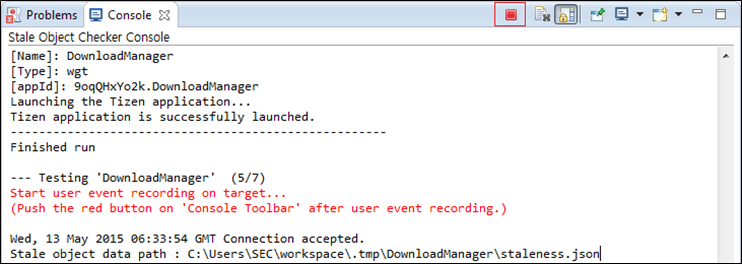
- After you stop recording, a confirmation message os displayed. Click OK.
The Stale Object Checker continues to inspect the data collected and launches a result page at http://localhost:9000. The result page can be accessed by any Web browser in the PC.
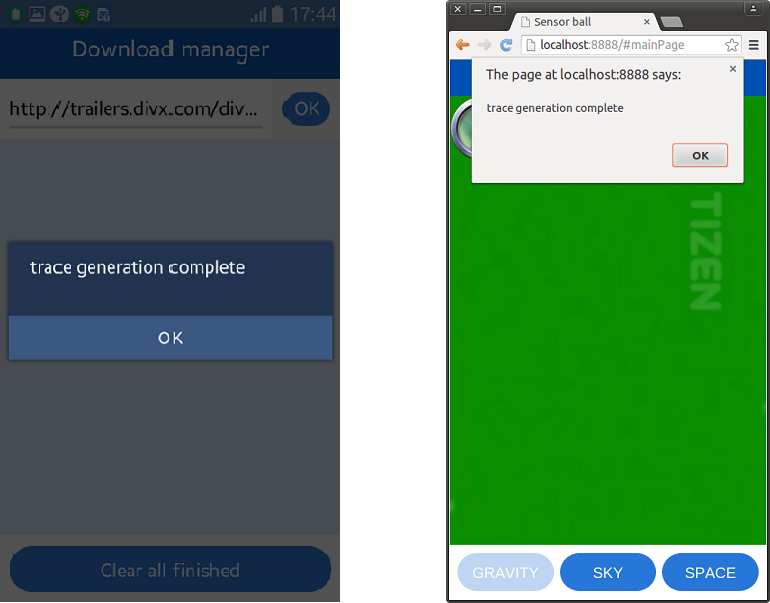
Result Page View
The result page opens with the view shown in the following figure. The page is composed of 2 parts: issue table and all-sites timeline. You can switch between the parts using the menu at the top of the page.
Figure: Result page with the issue table
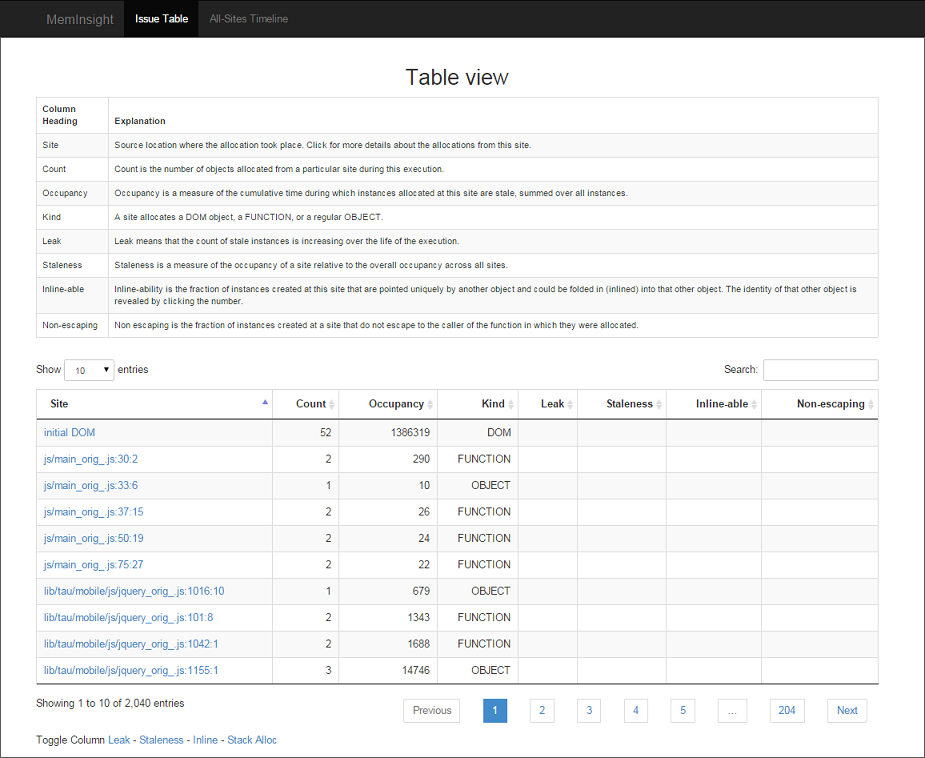
The following details are provided in the issue table:
- Site: Source location where the allocations took place. Click the site for more details about the allocation.
- Count: Number of objects allocated from a particular site during this execution.
- Kind: Site allocates a DOM object, a FUNCTION, or a regular OBJECT.
- Leak: Leak means that the count of stale instances is increasing over the execution lifetime.
A stale instance is any instance whose staleness value is not zero sat a specific time. The object staleness defines the time interval between the last use and the moment when the object is unreachable. For example, if the object has never been used, the staleness is the unreachable moment minus the creation time. If the object has been used, the staleness is the unreachable moment minus the last use time.
Issue Table
When you click a site in the issue table, a set of detailed information on a leak occurrence is shown. In the source view, you can easily find the code segment that steadily creates stale objects (possibly causing a memory leak), since it is marked with a colored box.
Figure: Detailed information
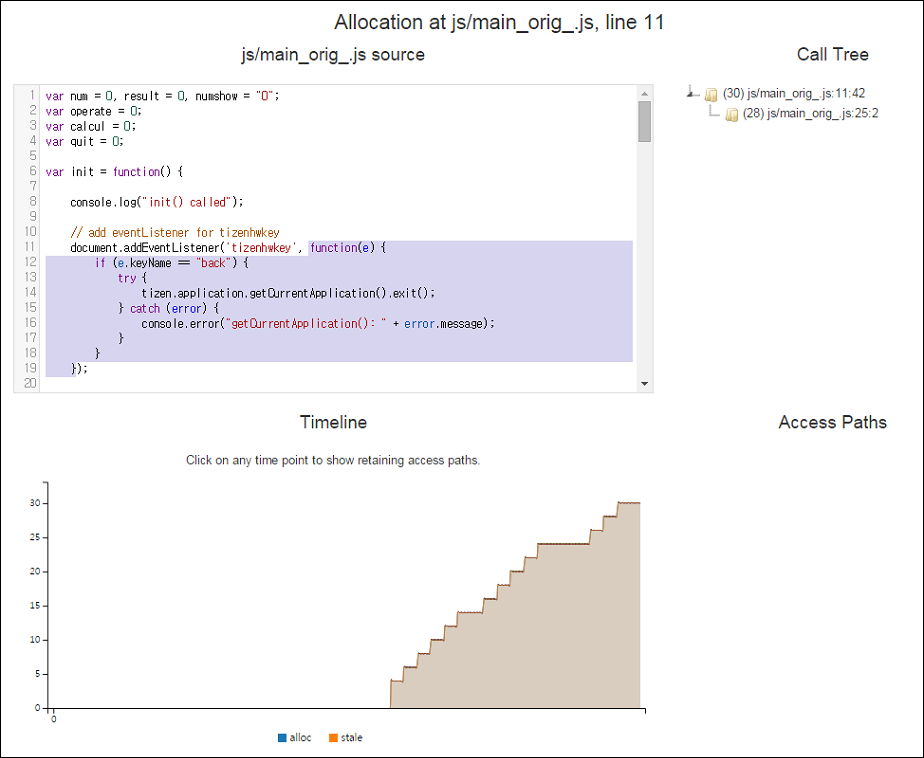
In the above figure:
- The anonymous event handler function at the line 10 is identified as a stale object that can cause a memory leak.
- In the call tree view, a call hierarchy is shown for the method which contains the code that creates stale objects. The name of a node in the call tree view indicates the file name, line number, and column number.
The "js/main_orig_.js:10:45" root element indicates that the memory leak occurs at line 10, column 45 in the js/main_orig_.js file.
Click the root element to move the source view to the location. Click the "js/main_orig_.js:27:5" child node to move the source view to line 27 where the method that contains the memory leak issue is called, and to highlight the method.
- In the timeline view, the x axis represents the time elapse and the y axis represents the number of created objects from this site. Move the mouse to a specific time to show the number of stale and allocated instances on the graph.
- In the access paths view, you can find out the scope of an object at runtime which leads to the location of the memory leak.
All-Sites Timeline
The all-sites time shows the timeline for all the objects created during the execution. The timeline graph in the issue table (figure above) shows the diagram for a specific site while the timeline in the all-sites page (figure below) indicates the diagram for all sites in the application. The pie charts shows the proportion of each site in all allocated and stale objects.
Figure: All-sites timeline page
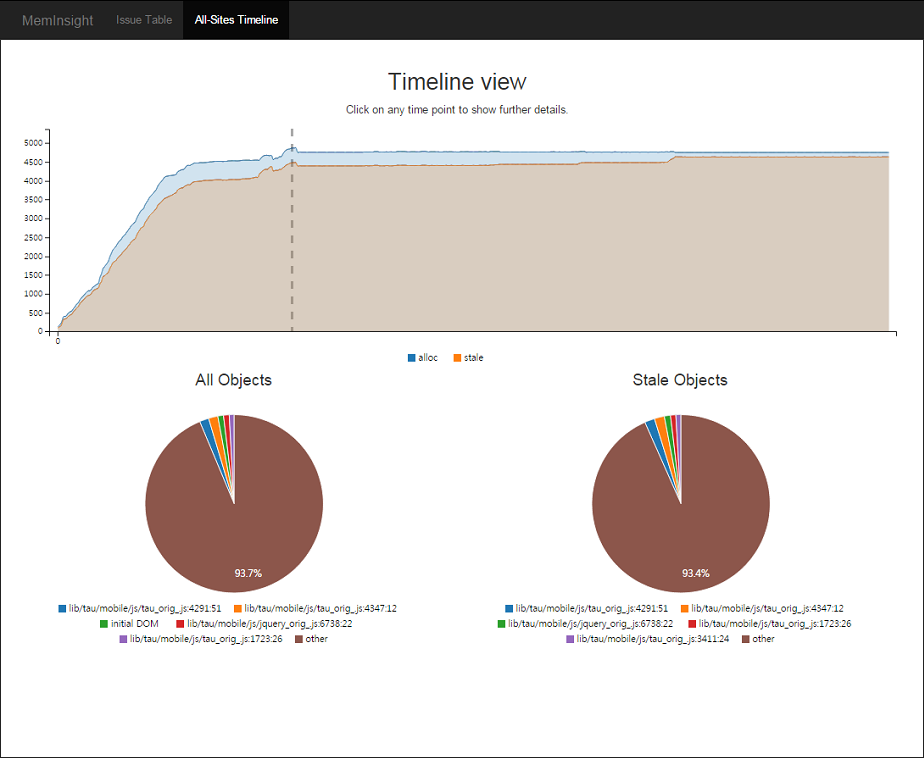
Timer Sample Code
When you click start, the Timer starts to run. If you click again, the timer stops. The exitApp() function registers an event handler for the Tizen Back key to terminate the application when the Back key is pressed.
In the runtime() function, the exitApp() function is added by mistake. As a result, every time you click start, the exitApp() function is called, creates an anonymous function, and registers it to listen to the Back key events. When you test this application with the Stale Object Checker, multiple start button clicks are shown as a memory leak.
/* JavaScript snippets */
function exitApp() {
document.addEventListener('tizenhwkey', function(e) {
if (e.keyName == 'back') {
try {
tizen.application.getCurrentApplication().exit();
} catch (error) {
console.error('getCurrentApplication(): ' + error.message);
}
}
});
}
function runtime() {
exitApp(); /* Add the function call for memory leak */
}
When testing the source code, the following figure shows the result. It indicates that a memory leak occurred at the "js/main_orig_.js:39:42" site. Clicking this site, the detailed information is retrieved.
Figure: Timer example issue table

Figure: Timer example detailed information
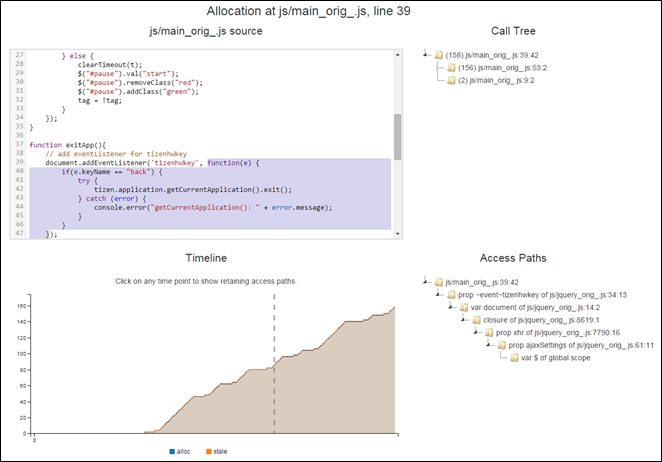
The detailed information shows that function object added to listen for "tizenhwkey" events caused a memory leak. If you click the "Call Tree" on the page, you can see that the exitApp() function with a memory leak issue is called in the runtime() function.
This code site is detected as a leak because the handler function objects created from the site have not been used before the application exits. The call tree says that when the runtime() function is executed, the exitApp() function is invoked, every time creates an anonymous function and registers it to a document object.
In the "Timeline" graph, you can see how the number of stale instances increases steadily. This graph shows any objects created from this code site that have not been used before the application exists.
Calculator Sample Code
When you click a number button, the command() function is executed. The init() function registers an event handler for the Tizen Back key.
In the command() function, the init() function is added by mistake. As a result, every time you click a number button, the init() function is called, creates an anonymous function, and registers it to listen to Tizen Back key events.
When you test this application with the Stale Object Checker and click a number button many times, the problem is diagnosed as a memory leak. When testing the source code, the result is the same as in the Timer example above.
/* JavaScript snippets */
var init = function() {
document.addEventListener('tizenhwkey', function(e) {
if (e.keyName == 'back') {
try {
tizen.application.getCurrentApplication().exit();
} catch (error) {
console.error('getCurrentApplication(): ' + error.message);
}
}
});
}
function command(num) {
init(); /* Add the function call for memory leak */
}


